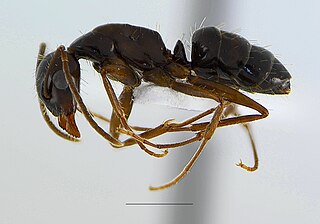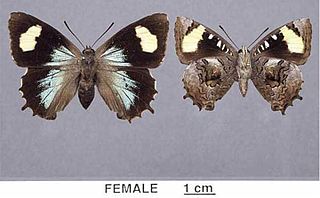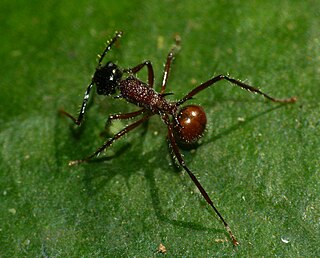
Honeypot ants, also called honey ants, are ants which have specialized workers that consume large amounts of food to the point that their abdomens swell enormously. Other ants then extract nourishment from them, through the process of trophallaxis. They function as living larders. Honeypot ants belong to any of several genera, including Myrmecocystus and Camponotus. They were first documented in 1881 by Henry C. McCook, and described further in 1908 by William Morton Wheeler.

Carpenter ants are large ants indigenous to many forested parts of the world.

The banded sugar ant, also known as the sugar ant, is a species of ant native to Australia. A member of the genus Camponotus in the subfamily Formicinae, it was described by German entomologist Wilhelm Ferdinand Erichson in 1842. Its common name refers to the ant's liking for sugar and sweet food, as well as the distinctive orange-brown band that wraps around its gaster.

The black carpenter ant is one of the largest and most common species of carpenter ant native to the central and eastern United States as well as eastern Canada.

Camponotus universitatis is a species of ant in the genus Camponotus, the carpenter ants. It is native to Eurasia, where it has been recorded in Spain, France, Italy, Switzerland, Albania, Bulgaria, and Turkey.
Colobopsis anderseni, synonym Camponotus anderseni, is a species of mangrove ant found in northern Australia.

Ogyris genoveva, the genoveva azure or southern purple azure, is a butterfly of the family Lycaenidae. It is found in Australia.

Polyrhachis is a genus of formicine ants found in the Old World with over 600 species. The genus is yet to be comprehensively resolved and contains many varied species including nest-weavers, swimming workers, soil and tree-dwellers. First fossil record of this genus was P. annosa from Miocene.

The golden tail sugar ant is a species of ant in the genus Camponotus. It is native to eastern Australia and was described by Gustav Mayr in 1862.

The black-headed sugar ant, also known as the brown sugar ant, is a species of Formicinae ant endemic to Australia. Found throughout most states, the species is a member of the genus Camponotus, a cosmopolitan genus of ants commonly known as carpenter ants. It was formally described and named by British entomologist Frederick Smith in 1858. These ants are characterised by their black head, reddish-brown mesosoma and black gaster, which can change in colour.
Camponotus clarior is a species of ant in the genus Camponotus. Described by Auguste-Henri Forel in 1902, the species is native to Australia.
Camponotus dryandrae is a species of ant in the genus Camponotus. Described by McArthur in 1996, the species is restricted to Western Australia.

Camponotus eastwoodi is a species of ant in the genus Camponotus. Described by McArthur in 1996, the species is restricted to Queensland and New South Wales.
Camponotus loweryi is a species of ant in the genus Camponotus. Described by McArthur in 1996, the species is found in multiple states in Australia.
Camponotus longideclivis is a species of ant in the genus Camponotus. Described by McArthur in 1996, the species is restricted to Western Australia.

Camponotus prostans is a species of ant in the genus Camponotus. Described by Auguste-Henri Forel in 1910, the species is restricted to Western Australia.

Camponotus elegans is a species of carpenter ants found in South East Queensland and Western Australia.

An ant garden is a mutualistic interaction between certain species of arboreal ants and various epiphytic plants. It is a structure made in the tree canopy by the ants that is filled with debris and other organic matter in which epiphytes grow. The ants benefit from this arrangement by having a stable framework on which to build their nest while the plants benefit by obtaining nutrients from the soil and from the moisture retained there.












